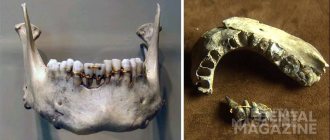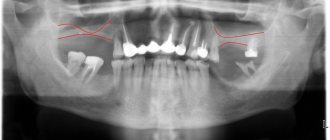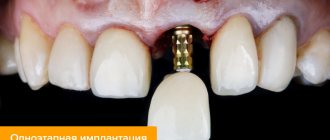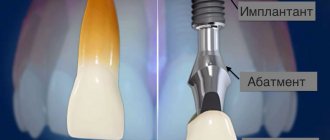To perform dental implantation at a high level with minimal trauma, a navigational surgical template is required.
Along with the active development of implantology, patients began to place higher demands on prostheses. Today, installed crowns must have not only ideal aesthetics, but also increased strength, convenience and safety for human health. This allows us to judge the need to use surgical templates made on the basis of modern computer technologies. They allow you to accurately determine the location for fixing the implant and select the correct angle of its inclination, which significantly improves the characteristics of future prostheses.
The Implantmaster clinic widely uses such navigational surgical templates, which ensures maximum accuracy of the implantation procedure, increases the chance of a successful outcome, minimizes the likelihood of tissue trauma and ensures shortened recovery times.
In this article we will talk in detail about the types and advantages of using the above surgical instruments, and also provide information about the features of implantation using such templates.
What is a surgical template for dental implants?
In the age of rapid technological development, patients are increasingly resorting to dental restoration procedures using dental implants. They no longer feel afraid of visiting dentists and consider implantation a completely comfortable process.
However, you can count on the success and complete safety of the method only if the following conditions are met: the fixation of dental systems is carried out by a highly qualified specialist, dentistry uses the latest technology, which also allows you to make a surgical template for dental implantation. Currently, the procedure using the above templates is known as "Implant surgical guide".
Why is it necessary?
The surgical template is a structure shaped like a boxing mouthguard, with identical holes present on the surface. The main purpose of the products is to accurately determine the implantation zone. With the help of the design, the implant is implanted steadily and along the contour.
They are made individually for each patient, based on the characteristics of the jaw and the location of the patient’s teeth.
Their main purpose is to ensure the exact location of the artificial tooth in the dentition.
The materials used for manufacturing are lightweight - acrylic, plastic, polymer, so the product is easy to use.
The key to accurate implant placement is a surgical template
In appearance, the surgical implant template is identical to a mouthguard made of transparent material and used to prevent dental injuries during sports events. The only difference between such products is the presence of holes with the same diameter.
However, for any competent specialist involved in the fixation of dental structures, surgical navigation templates are auxiliary devices made in accordance with the individual parameters of each patient and allowing the placement of implants in the oral cavity with maximum accuracy
With the help of such a tool, the dentist is able to fix implants in the jaw bone not only with perfect accuracy, but also in a short time, with minimal surgical intervention, and even in difficult situations, in the absence of sufficient bone tissue.
In the case of using the above device, not only the doctor, but also the patient receives a guarantee, since in this case any negative consequences are excluded, as well as the possibility of injury to the maxillary cavities.
How is 3D implantation performed?
The surgeon fixes the template in the patient’s mouth and places the implants exactly according to it. Flap surgery is not required: the doctor makes only small punctures in the gum, the diameter of which corresponds to the size of the implants. Thus, the traumatism of the operation is minimized, the gums do not need to be sutured, and there is no risk of developing inflammation with good oral hygiene. Implantation is performed under local anesthesia. It takes 10 minutes to install one implant. The possible error does not exceed 20 microns.
Clinical case StomArtStudio Leonardo, doctor Vasiliev Leonid Alekseevich
Our team of doctors
Maxillofacial surgeon, Implantologist
Bocharov Maxim Viktorovich
Experience: 11 years
Dental surgeon, Implantologist
Chernov Dmitry Anatolievich
Experience: 29 years
Orthopedist, Neuromuscular dentist
Stepanov Andrey Vasilievich
Experience: 22 years
Endodontist, Therapist
Skalet Yana Alexandrovna
Experience: 22 years
Orthopedic dentist
Tsoi Sergey Konstantinovich
Experience: 19 years
Dentist-orthodontist
Enikeeva Anna Stanislavovna
Experience: 3 years
The need to use a surgical template
The production of surgical templates is not carried out in all situations that arise in implantology practice. If several teeth are missing in the chewing area, there is no need to use the above tools. But when it is necessary to perform more complex procedures involving the fixation of a large number of dental structures, a surgical template is an indispensable device for dental implantation, since they allow one to clearly define the site for the location of future titanium structures.
In addition, the guides described above can be used when it is necessary to restore teeth in the frontal area, when achieving perfect aesthetics is a priority. However, in this case, much depends on the level of professionalism of the surgeon.
If there is a situation of bone deficiency, a surgical template for implantation often avoids osteoplasty (sinus lift). Thanks to it, the installation of dental implants can be performed in an area that is resistant to increased stress.
In what cases is a navigation template used?
It is advisable to use a surgical template for implantation in the following situations:
- The need to restore teeth in the frontal part of the jaw;
- If there is a shortage of more than a few units in a row;
- The need to implement a minimally invasive treatment method;
- If any pathologies are detected in the structure of the jaw system, which causes the need for drilling at an angle;
- If the installation of a temporary orthopedic structure is carried out immediately after fixation of a dental implant (one-stage dental implantation);
- Fixation of an orthopedic structure of a removable or conditionally removable type;
- In the presence of atrophic processes in bone tissue, provoking the need to place implants in areas directed towards other bones.
Prosthetics
Immediately after surgery, a healing abutment, temporary crown, or bridge can be placed on the implants. They need to be worn for 2 - 4 months while the process of osseointegration takes place - the artificial tooth roots must be securely and firmly fixed in the jaw and overgrown with bone tissue. The temporary structure does not reveal itself in any way and does not differ in appearance from natural teeth. After completion of osseointegration, the patient is invited to install a permanent crown or prosthesis made of ceramics, metal-ceramics, zirconium dioxide - the material is selected at the request of the patient.
Making a Surgical Template
The procedure for obtaining the above device involves the participation of several specialists: an experienced surgeon, an orthopedist and a dentist. The process of making templates is carried out in several successive steps, which we will discuss below:
- Preparation. Includes diagnostic procedures, implementation, as well as a mandatory assessment of the clinical situation. The need to obtain it is determined not only by the choice of a suitable orthopedic design, but also by the precise determination of the location of the implant;
- Obtaining an impression. Thanks to the use of modern scanning devices, which include 3Shape, it is possible to obtain an impression of the jaw in digital format and instantly transfer it to the laboratory to create a prosthesis;
- Modeling in 3D format. Based on the use of a modern computer application, which allows you to simulate the method of performing surgical intervention, determines the location of future dental structures;
- Template production. It is carried out either in laboratory conditions or using CAD/CAM equipment. The first option involves the participation of a specialist, the second allows you to obtain a template using computer technology and a large-scale printing device.
Features and disadvantages of the traditional method
The classical method of implant installation is based on the presence of the human factor. The surgeon who performs the operation may make a mistake, as a result of which the life of the implant is reduced. The following errors are considered the most common:
• Installation of the implant is not along a given axis, and therefore the crown is inevitably fixed at an angle to the artificial root. This increases the load on the tooth; • Displacement from the intended location when installing a titanium screw into the jaw. In this case, food debris will accumulate under the crown; • Excessive force when drilling into bone. This can cause damage to the maxillary sinus or mandibular nerve.
Implantologist errors can be caused by various factors. For example, difficult access to chewing teeth or the patient’s inability to open his mouth wide or maintain this position during manipulation. The doctor's experience and qualifications also matter. But, regardless of the reason, possible errors can be eliminated.
Materials used in the manufacture of a surgical template
There is the following classification of materials from which a surgical template for implantation is made, depending on the technologies used and the components used:
- Transparent . They are distinguished by increased strength and, at the same time, softness. The required degree of transparency is achieved through the use of a vacuum former in the manufacturing process of such structures;
- Acrylic . This device is identical to a removable orthopedic structure of the classic type, which has a gingival base. Initially, the doctor creates an impression, which is subsequently transferred to the laboratory for making a model. The popularity of the above models is due to their affordable cost;
- Plastic . For their production, special medical plastic is used, which has extreme parameters of strength and elasticity;
- Made using the CAD/CAM method . In the process of using this digital technology, it is possible to obtain ultra-precise, improved designs that are characterized by increased heat resistance and strength. This surgical template for dental implantation is one of the most expensive, due to the labor-intensive production process.
Types of surgical templates for dental implantation
During the installation of orthopedic structures, the following templates are used:
- With fixation on bone tissue. To install this design, special microscrews are used. Such a surgical template is fixed to the edentulous jaw, which contributes to increased precision of the procedure and allows you to choose the area with the remaining bone as a support. In the process of this manipulation, patchwork components are used;
- Using nearby healthy organs as support. In order to attach the model, elements located in the dental arch during the surgical operation are used. This is a suitable option for people with partial absence of teeth. Recommended if it is not possible to use the flapless method;
- With fixation on soft tissues. The gingival mucosa is used as an anchor for the frame. This template is indispensable if there is an absolute lack of teeth in the jaw. Most often used as part of non-invasive intervention.
Advantages and disadvantages of navigation templates
The benefits of using such surgical devices include:
- Maximum accuracy of the procedure, since the risk of human errors is eliminated;
- High probability of a favorable outcome of surgical intervention;
- Reduced procedure time, since the location of fixation of dental implants is determined in advance;
- Minimal risk of injury: when a surgical template is used for dental implantation, instead of cutting into the gum tissue, a puncture is made in the area indicated on this navigation device;
- Short healing period. The likelihood of inflammation and swelling after the procedure is minimal.
Flaws:
- It takes a certain amount of time to produce the template (about 2-3 days), which can be inconvenient for many patients;
- If such a surgical instrument is involved in the process of fixing implants, the cost of the procedure can increase significantly.
General overview
Experts note that the use of surgical templates is a serious step in the development of implantation. The device, which is similar in appearance to a sports mouthguard, follows the shape of the jaw row, but at the same time a number of holes with the same diameter are placed in its surface, allowing the dentist to determine the area of integration of the artificial base. Tight fixation eliminates displacement during the formation of channels for implant placement, increasing the accuracy of prosthetics.
Templates, made taking into account the anatomical features of the structure of the jaw apparatus, ensure precise fitting of artificial crowns after installation. Thus, as a result of the restoration, a complete dentition is created that corresponds to the patient’s occlusion and bite, and does not require getting used to the implants.
Price of a surgical template at the Implantmaster clinic
If you are interested in a surgical guide for implantation, the price of this device may vary based on the technique used, the material involved and the number of guides. For example, an acrylic surgical template for implantation can cost more than 6,000 rubles in Moscow, provided that at least three dental units are fixed. In turn, a template obtained in three-dimensional format using innovative technologies will cost you at least 30,000 rubles.
This amount is added to the cost of dental implantation.
Navigated implantation VS Manual implantation
If we summarize all the above-mentioned advantages of implantation using a template, then in terms of all characteristics, preference should still be given to modern digital technology over the old, but cheaper method.
| Navigated implantation with surgical template | Manual implantation | |
| Degree of injury | Low | High |
| Positioning accuracy | High | Low |
| Time | From 20 minutes to 1 hour | From 1 hour to 6 hours |
| Possibility of rejection | Low | Average |
| Recovery period | 1-2 days | 3-10 days |
| Price | 150-1000 € | Included in the cost of the procedure |
Myths about using a surgical navigation template
1. When using such a surgical instrument, the price of implantation services increases significantly, which is why it is prescribed to patients. It is better to find a competent and honest specialist.
It should be noted that no matter how qualified and conscientious a surgeon is, a person cannot surpass high-precision computer calculation technologies and digital technology. In this case, the human factor plays an important role, since the doctor may be tired, stressed or ill.
That is, if a specialist talks about using a surgical template, this indicates his responsible approach to his work and his patients.
2. The use of a template indicates a low level of professionalism of the dentist.
This is also a mistaken opinion. As practice shows, only incompetent specialists demonstrate complete confidence in their professional skills. A competent doctor understands that errors and miscalculations are possible when performing any dental procedures, and makes every effort to prevent them.
This is precisely what formed the basis for the creation of a surgical template: with its help, it is possible to eliminate many serious shortcomings when performing dental implantation.
3. Why make any markings on the jaw? A dental implant can take root in any area.
In addition to fixing the implant, the installation of an orthopedic structure is of great importance, which must have the following characteristics:
- Strength, which ensures resistance to any chewing loads;
- Safety for the human body, which eliminates the possibility of bone tissue destruction;
- Convenience, which increases patient comfort during use;
- Aesthetic perfection.
This indicates the importance of choosing the right location and determining the exact inclination of fixation of dental structures, which play the role of supports for future crowns.
Author:
How is it different from traditional
Traditional implantation is a surgical operation in which the doctor makes tissue incisions: he cuts the gum above the alveolar ridge using a patchwork method, peels off the mucous membrane and periosteal tissue. After screwing in the titanium rod, the gum is sutured.
In addition to being traumatic, traditional implantation is associated with a lengthy operation and the risk of negative side effects and complications. Other disadvantages include: the length of the recovery period and the need for preliminary bone augmentation if the volume is insufficient.
The use of surgical templates for dental implantation makes it possible to predict the outcome of treatment due to the accuracy of planning.








